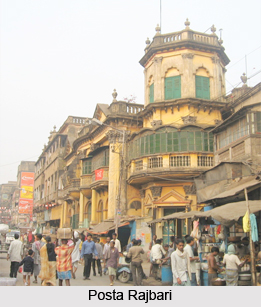 Posta was once the princely place in Kolkata. In medieval era, the name of Posta can"t be heard, but with the emergence of British East India Company in India, soon after the Battle of Plassey in 1757, where Siraj ud daulah was defeated by Robert Clive, Posta became the place of Babus. It has the market and it is very near to Burrabazar. Now Posta is a busy market area in Kolkata and the condition of Posta Rajbari is in dire condition.
Posta was once the princely place in Kolkata. In medieval era, the name of Posta can"t be heard, but with the emergence of British East India Company in India, soon after the Battle of Plassey in 1757, where Siraj ud daulah was defeated by Robert Clive, Posta became the place of Babus. It has the market and it is very near to Burrabazar. Now Posta is a busy market area in Kolkata and the condition of Posta Rajbari is in dire condition.
Location of Posta
Posta is a now an urban busy area in central Kolkata, West Bengal.
History of Posta
Posta was once a citadel of Bengali mercantile aristocracy; it is now an extension of the wholesale market in neighbouring Burrabazar, dominated by Marwaris. The wholesale market features a wide range of products such as edible oil, salt, cereals, spices, food grains, sugar, and vanaspati products. In the early phase of modern era, when British East India Company came in the eastern belt of India that is Kolkata, when it was named as Alinagar, Posta became the favourite place for Bengal aristocratic people. Posta Rajbari came into existence while British East India Company began the trading contact with the Seth sand Basaks for textiles. The name Posta came from Posta Ghat. Sukhamay Ray was the founder of Posta Rajbari. The area was earlier occupied by Bengali merchants and bankers, whose riches were legendary. One such merchant was Nuku Dhar, or Lakshmikanta Dhar, who came from Hooghly when it was in decline and settled in Sutanuti. He is believed to have lent the English rulers nine lakh rupees during their campaign against the Marathas. He used to lend money to Robert Clive regularly. It is said that when Nabakrishna Deb approached him for a job, he introduced him to the English and they took him in. Sukhamay Roy the grandson of Nuku Dhar, inherited his maternal grandfather"s wealth because his mother was the only child of Nuku Dhar and he was the only grand child. When the British wanted to bestow on Nuku Dhar the title of "Raja", he requested them to honour his grandson with the title. The request was acceded to and Raja Sukhamay Roy was the founder of the Posta Raj family followed by Sri Bishnu Prosad Roy, Sri Pashupatinath Roy, Sri Jitendra Nath Roy, Sri Samir Roy, Sri Pronab Kumar Roy, Sri Prodyut Kumar Roy, Sri Dilip Kumar Roy, Sri Amit Kumar Roy, Sri Kaushik Roy, Sri Arnab Roy, Sri Priyojit Roy, Sri Abhishek Roy, Sri Riddhiman Roy and Sri Kuntal Roy. Posta Rajbari has three buildings like Lalbari, Rajbari and Thakurbari.
Posta as the Whole Sale Market
Posta is now converted as the whole sale market. The neighbourhood was earlier called Amposta as it was a wholesale market for mangoes. Now, it is no more so. Parts of the neighbourhood are called Aluposta, wholesale market for potatoes, and Dalposta, wholesale market for lentils.
Related Articles
Capital Cities of India
Kolkata
History of Kolkata
Culture of Kolkata
Economy of Kolkata
West Bengal, Indian State
Alipur , Kolkata
History of Alipore Zoological Gardens
Agri Horticultural Society of India
Agro-Horticultural Gardens
Alipore Bomb Case
Revolutionary Terrorist Movement in India



















